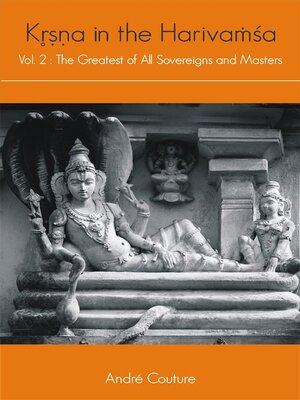Kr̥ṣṇa in the Harivaṁśa (Vol II)
ebook ∣ The Greatest of All Sovereigns and Masters
By André Couture

Sign up to save your library
With an OverDrive account, you can save your favorite libraries for at-a-glance information about availability. Find out more about OverDrive accounts.
Find this title in Libby, the library reading app by OverDrive.



Search for a digital library with this title
Title found at these libraries:
| Library Name | Distance |
|---|---|
| Loading... |
This second volume of Krishna in the Harivamsha brings together texts written between 2000 and 2015, more than half of which are of more recent vintage than those included in Volume I. While Krishna's biography is clearly divided into two large units, childhood and adulthood — the kshatriya (warrior) of the second period manifesting himself first as a gopa (cowherd) — it is important to note that both sections of the biography are similarly structured and carry an identical message. This book contends that the child and adult Krishnas are indeed one and the same.
The initiation by guru Kashya Sandipani, the construction of the city of Dvaraka, and the fights involving Pradyumna and Aniruddha are among the best known episodes analysed in this volume. It is the oft-neglected Harivamsha version of these well-known stories that is studied here, version that has been passed over despite its early date of composition.
An unstated assumption still influences a great deal of Harivamsha research. Many scholars assume that an addition of this sort to the Mahabharata can be little more than a collection of ancient records bearing witness to the primitive mentality of a people unable to think logically. On this view, the Harivamsha becomes reduced to a pile of documents of diverse origins. The articles contained in this volume take the opposite view. Krishna's biography, which at first blush might appear to be an amalgam of various stories, proves in fact to be a skilful construction which conveys a clear message.
The initiation by guru Kashya Sandipani, the construction of the city of Dvaraka, and the fights involving Pradyumna and Aniruddha are among the best known episodes analysed in this volume. It is the oft-neglected Harivamsha version of these well-known stories that is studied here, version that has been passed over despite its early date of composition.
An unstated assumption still influences a great deal of Harivamsha research. Many scholars assume that an addition of this sort to the Mahabharata can be little more than a collection of ancient records bearing witness to the primitive mentality of a people unable to think logically. On this view, the Harivamsha becomes reduced to a pile of documents of diverse origins. The articles contained in this volume take the opposite view. Krishna's biography, which at first blush might appear to be an amalgam of various stories, proves in fact to be a skilful construction which conveys a clear message.







